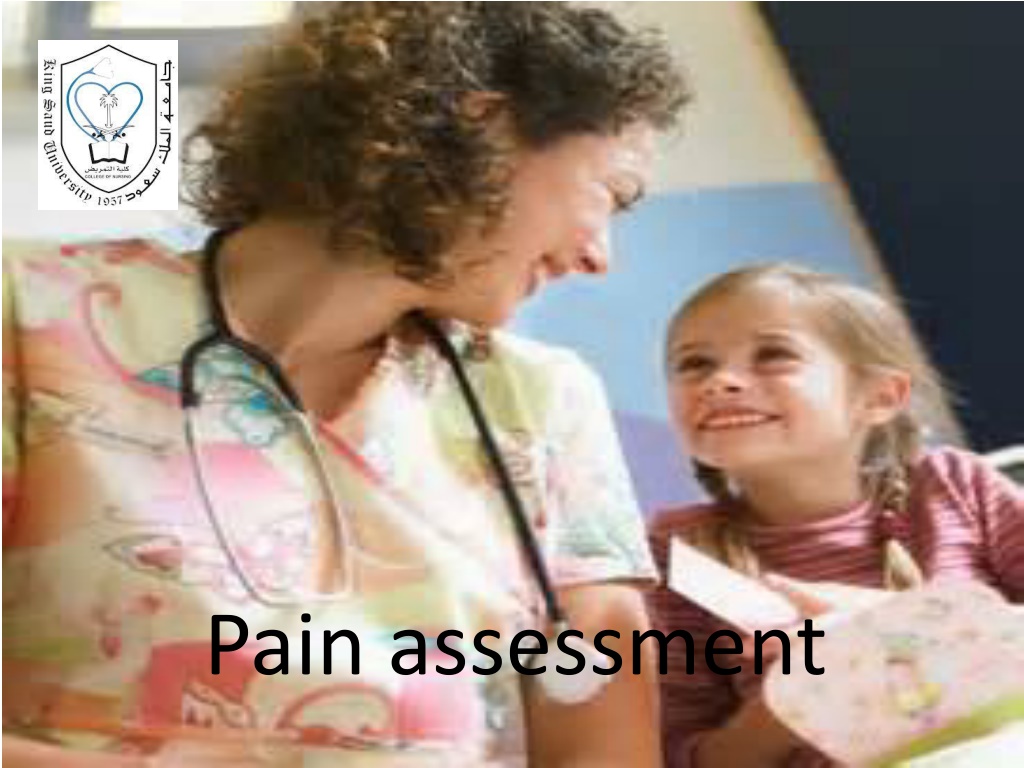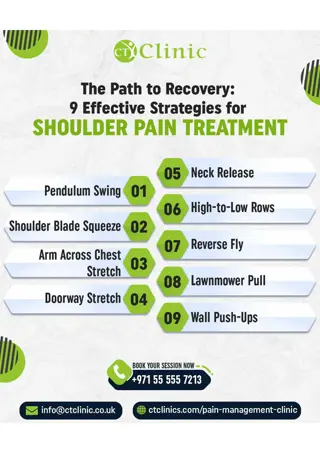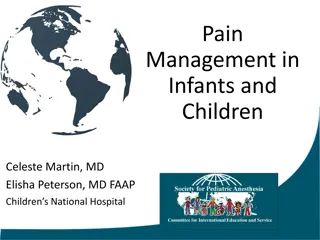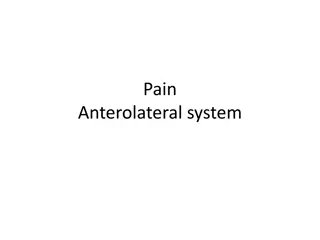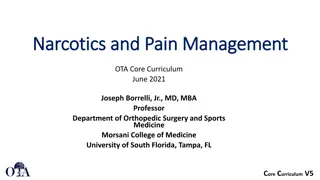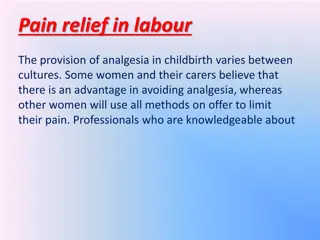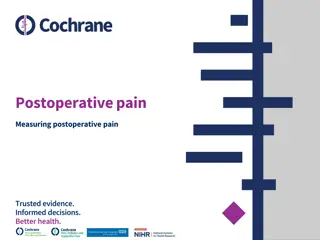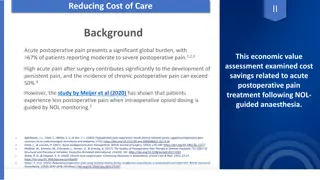Understanding Pain Assessment: Factors, Tools, and Relief
Pain assessment is crucial for understanding and managing patients' pain perception. This involves identifying different forms of pain, factors affecting pain sensitivity, behavioral responses to pain, and utilizing pain assessment tools for accurate evaluation. Factors influencing pain sensitivity include discomfort, anxiety, and depression, while relief can be achieved through sleep, rest, and companionship. Utilizing pain assessment charts and intensity tools aids in effective pain management.
Download Presentation

Please find below an Image/Link to download the presentation.
The content on the website is provided AS IS for your information and personal use only. It may not be sold, licensed, or shared on other websites without obtaining consent from the author. Download presentation by click this link. If you encounter any issues during the download, it is possible that the publisher has removed the file from their server.
E N D
Presentation Transcript
Pain assessment Pain assessment
Objectives: At the end of this lecture, the students will be able: 1.identify the purpose of pain assessment. 2.recognize form of pain. 3.list factors affecting pain sensitivity. 4.discuss behavioral of responses to pain. 5.follow and use pain assessment chart.
Definition of pain: Pain is not a simple sensation but a complex phenomenon which have both a cognitive (physical) and an affective ( emotional) component. ''pain is whatever the experiencing person says it is ,existing whenever the experiencing person says it does .
Purpose: The purpose of pain assessment is to identify all the factors affecting the patient perception of pain.
Types of pain: There are various ways of classifying the types of pain -onset of occurrence ,such as postoperative pain -duration , such as acute or chronic pain -severity or intensity ,such as severe or mild or 0 to 10 on a scale -mode of transmission , such as normal pain pathways or referral pain -location or source, such as superficial , deep , or central pain -causation , such as receptor stimulation , or psycho physiological pain
Factors affecting pain sensitivity Increased by: -Discomfort -Insomnia -Fatigue -Anxiety -Fear -Anger -sadness -Depression -Boredom
Relief of symptoms Lowered by: -Sleep -Rest -Sympathy -Understanding -Companionship -Diversional activities -Reduction in anxiety -Elevation of mood
Pain assessment tools: 1/pain assessment charts 2/pain intensity assessment chart 3/key to pain intensity
: Behavioral responses to pain Behavioral responses and verbal descriptions of pain by children of different developmental stages: Age group Infants <6 months 6-12 months Behavioral response Generalized body movements . Chin quivaring , fucial grimacing. Reflex withdrawal to stimulus,facial grimacing , disturbed sleep, irritability, restlessness Verbal description Cries cries Toddlers 1-3 years Localized withdrawal , resistance of entire body Aggressive behavior , disturbed sleep Cries and screams, cannot describe intensity or type of pain.
Preschoolers 3-6 years Active physical resistance Directed aggressive behavior Strikes out physically and verbally when hurt, low frustration level Can identify location of pain , denies pain , may believe his or her pain is obvious to others. School age children 7-9 years 10-12 Passive resistance, clenches fiats , holds body rigidly still , suffers emotional withdrawal , engages in plea bargaining May pretend comfort to project bravery , may regress with atress And anxity Can specify location of pain and describe its physical characteristics Able to describe intensity and location with more characteristics , able to describe psychologic pain Adolescents 12-18 years Want to behave in a socially acceptable manner (like adults) show acontrolled behavioral response More sophisticated description as experience is gained
Guidelines for pain assessment: A:initial assessment: Action Rationale 1.Explain the purpose of using the chart to the patient. To obtain the patients and cooperation . To encourage patients participations. 2. When appropriate, encourage the patient to complete the pain chart himself/herself. 3.Where the nurse completes chart, record the patients own description of his/her pain. To reduce the risk of misrepresentation.
Continue 4.(a)Record any factors which influence the intensity of the pain, e.g. activities or interventions which reduce or increase the pain, such as, distractions or heat pad. (b)Record whether or not the patient is pain freeat night, at rest or on movement. Ascertaining how and when the patient experiences pain, enables the nurse to plan realistic goals.For example, relieving the patients pain during the night and while he /she is at rest is usually easier to achieve than relieving pain on movement.
B:pain sites: action Rationale 1.Encourage the patient, when appropriate to identify pain himself/herself. The body outline is ideally a vehicle for the patient to describe own pain experience. 2.Index each site(A to H)in whatever way seems most appropriate, e.g. shading or coloring of areas or arrows to indicate shooting pain. This enables individuals pain sites to be located.
C:monitoring pain intensity: Action Rationale 1. Give each pain site a numerical value according to the key of pain intensity or the pain scale and note time recorded. 2.Record any analgesia given and note route and dose. To indicate the intensity of the pain at each site. To monitor the efficacy of prescribed analgesia. 3.Record any significant activities, which are likely to influence the patients pain. Extra pharmacological or non- pharmacological interventions might be indicated.
Note: fixed times for reviewing the pain have been omitted intentionally to allow for flexibility. It is suggested that , initially, the patients pain has to be reviewed every four hours.When patients level of pain has stabilized, recording may be made less frequently,e.g. 12-hourly or daily. The chart should be discontinued if patients pain becomes totally controlled.
